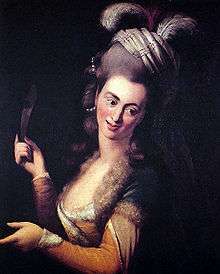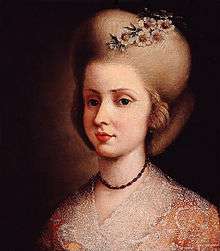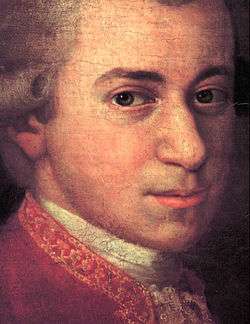Aloysia Weber

Maria Aloysia Antonia Weber Lange (c. 1760 – 8 June 1839) was a German soprano, remembered primarily for her association with the composer Wolfgang Amadeus Mozart.
Biography
Born in Zell im Wiesental, Aloysia Weber was one of the four daughters of the musical Weber family. Her three sisters were soprano Josepha Weber (1758–1819), who premiered the role of the Queen of the Night in Mozart's The Magic Flute; Constanze Weber, the wife of Mozart; and Sophie Weber. Her half-first cousin was the composer Carl Maria von Weber.
Shortly after her birth, the family moved to Mannheim and Aloysia grew up there; she moved to Munich in 1778, where she made her operatic debut. Her salary at the Court Theater was 1000 florins per year; her father made 600.[1] The following year, she was engaged to sing in the National Singspiel in Vienna, a project of the Emperor Joseph II; the family moved together to Vienna in September, where the father worked briefly as a ticket-taker, but he died suddenly only a month after their arrival.
Aloysia continued in a fairly successful singing career in Vienna over the next two decades.
On 31 October 1780, she married Joseph Lange, an actor at the Court Theater who was also an amateur painter (he later produced a well-known portrait of Mozart).[2] It was Lange's second marriage after his first wife had died in 1779. Since Aloysia was the main support of her family at the time, Lange agreed to pay her mother an advance of 900 florins and the sum of 700 florins per year on a continuing basis.[3]
She moved to the Burgtheater in 1782, singing Italian opera. This position lasted only eight months, as she soon became "persona non grata owing to disagreements over salary and role distribution as well as missed performances."[2] She continued to sing, however, at the Kärntnertortheater as well as in occasional roles at the Burgtheater. In 1795, she went on concert tour with her widowed sister Constanze. As of that year, she ceased to live with her husband Lange.[4]
She spent her old age in Salzburg in order to be near her surviving sisters Constanze and Sophie, who had moved there.
Her relationship with Mozart
She was for some time a love interest of Wolfgang Amadeus Mozart. This was around 1777, when Mozart spent some time in Mannheim, where he had hoped (in vain, it turned out) to find employment. Mozart expressed a desire to marry Aloysia, though it is not clear exactly how serious his intentions were, or whether they were reciprocated.
Mozart left Mannheim for several months for Paris on an unsuccessful job search. On his way back to Salzburg, he passed through Munich, where Aloysia was by now employed. According to the tale told in Georg Nikolaus von Nissen's draft biography of Mozart, Mozart and Aloysia had a rather unpleasant encounter:
When he entered, she appeared no longer to know him, for whom she previously had wept. Accordingly, he sat down at the piano and sang in a loud voice, "Leck mir das Mensch im Arsch, das mich nicht will" (The one who doesn't want me can lick my ass).[5]
The vulgar phrase in Mozart's song corresponds to the English idiom "kiss my ass", and occurs frequently in Mozart's letters; see Mozart and scatology.
Mozart himself moved to Vienna in 1781, and later that year was for a time a lodger in the Weber home. The father Fridolin had died in 1779, and Aloysia's mother Cäcilia Weber was taking in boarders to make ends meet. Mozart fell in love with the third daughter, Constanze. When the two married in 1782,[6] Mozart became Aloysia's brother-in-law. Apparently there were no long-term hard feelings, as Mozart wrote a fair amount of music for Aloysia to sing, listed below.

Music written by Mozart for Aloysia Weber
From the Mannheim visit:
- Recitative and Aria for Soprano, "Alcandro, lo confesso", K. 294)
- Recitative and Aria for Soprano, "Popoli di Tessaglia!", K. 316/300b.[8] This has a range up to G6, which earned it a listing in Guinness lists as the highest demanded note in the classical repertoire.
From the Vienna years:
- Aria for Soprano, "Nehmt meinen Dank, ihr holden Gönner!", K. 383[8]
- Scena and rondo "Mia speranza adorata – Ah, non sai, qual pena", K. 416, completed in Vienna 8 January 1783 and premiered by Aloysia on the 11th at a concert in the Mehlgrube, site of the later premiere of many of Mozart's piano concertos.[9]
- Mozart wrote two "substitution arias" for Aloysia, inserted into a revival production (June 1783) at the Burgtheater[10] of Pasquale Anfossi's opera Il curioso indiscreto.[2] These were "Vorrei spiegarvi, oh Dio!" K. 418 and "No, no, che non sei capace" K. 419.
- The role of Mme. Herz in the short singspiel Der Schauspieldirektor K.486, consisting of one aria "Da schlagt die Abschiedsstunde," a trio, and the vaudeville finale. This occasional piece was written for an elaborate party given by the Emperor Joseph II in February 1786.
- Aria for Soprano, "Ah se in ciel", K. 538 (1788)
Mozart opera roles sung by Aloysia Weber
- Donna Anna, in Mozart's Don Giovanni at the Vienna premiere of the work, 7 May 1788
- Constanze, in a revival production of Die Entführung aus dem Serail (1785–1788)
- Sesto, in a widow's benefit performance of La Clemenza di Tito (1795)[11]
Assessment
Joachim Daniel Preisler, a Danish actor and musician, was sent on tour by his employer, the Royal Theater in Copenhagen, to study opera production in other European countries. While in Vienna he was invited into the Lange home, where he heard the pregnant (and thus not performing) Aloysia sing. In his diary, he wrote:
The voice is something exceptional! but ... not by a long way as good as our Müller;[12] yet her high range and her delicacy, her execution, taste and theoretical knowledge cannot fail to be admired by any impartial critic. ... She can sing the longest and most difficult parts incomparably better than the [Italian] songstresses who are here pamperd by the Viennese nobility.[13]
Preisler's testimony also indicates that Aloysia was not just a fine singer, but an outstanding general musician:
The well-known Mozardt is her brother-in-law, and has taught her so well that she accompanies from a score and plays interludes like a Kapellmeister.[13]
Aloysia Weber in fiction
Mozart's and Aloysia's ill-fated romance is novelized in Mozart's Wife by Juliet Waldron (Hard Shell Books, 2000). A somewhat more fanciful portrayal is given in Marrying Mozart by Stephanie Cowell (New York: Penguin, 2004).
Notes
- ↑ Einstein 1962, 63
- 1 2 3 New Grove online, "Weber" 2007
- ↑ Joseph Lange, Biographie des Joseph Lange, k.k. Hofschauspielers, Vienna 1808, p. 117
- ↑ Deutsch, 503
- ↑ Quoted from Solomon 1995, 169. The published version of Nissen's biography bowdlerized the text, substituting "Ich lass das Mädel gern, das mich nicht will" (I'd gladly give up the girl who doesn't want me).
- ↑ New Grove online, "Mozart" 2007
- ↑ Solomon (1995, 173). The portrait is in a private collection.
- 1 2 Schirmer's Library of Musical Classics, Vol. 1751, introduction.
- ↑ Deutsch 1965, 212
- ↑ Deutsch 1965, 217. This was Aloysia's "first appearance at the Italian opera", and it was very positively received (Deutsch 218).
- ↑ http://www.biographien.ac.at/oebl_4/446.pdf
- ↑ Caterine Möller, prima donna of the Royal Theater in Copenhagen; Deutsch 1965, 324
- 1 2 Deutsch 1965, 324
References
- Deutsch, Otto Erich (1965) Mozart: A Documentary Biography. Stanford, CA: Stanford University Press.
- Einstein, Alfred (1962) Mozart: His Character, His Work. Oxford University Press.
- Grove Dictionary of Music and Musicians, online edition, article "Weber". 2007, Oxford University Press.
- Solomon, Maynard (1995). Mozart: A Life. New York: Harper Collins. ISBN 0-06-019046-9.
